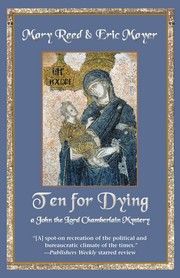


1482054 Curiosities served
Inspiration
Previous Entry :: Next Entry
Read/Post Comments (7)
China Mieville's science fiction/mystery The City and the City employs a similar concept, imagining two cities which co-exist in the same space and time. However, I was struck by Mieville's originality. For one thing, the city/cities are vaguely eastern euopeon rather than London. More importantly, the cities and their inhabitants occupy the same space and time but the inhabitants of one city are barred by law and custom from noticing the buildings and people of the other. They must "unsee" the others, and to fail to do so results in the much dreaded "breach."
I rather promptly discovered that brilliant as I found The City and the City the concept wasn't as original as I'd supposed. By chance I read All Hallows Eve, the 1945 book by British author Charles Williams, in which the recently dead wander the streets of The City, a mystical London coexisting with the actual, living London. The dead are usually invisible to the living, but at one point, a magician summons a dead woman, and their interaction is observed:
He saw, visibly before him, the breach of spiritual law.... The exchange of smiles-if that which had no thought of fair courtesy could be called exchange; at least some imitation of smiles-passed between them. Separately, each of them declined the nature of the City; which nevertheless held them. Each desired to breach the City; and either breach opened-directly and only-upon the other."
"Breach" is a perfect word for the situations described by Mieville and Williams -- it is both an opening between the worlds and a violation of the laws (in Williams' case spiritual laws) that govern them. But I have to think Mieville must have borrowed the term from Williams. According to one source he listed Charles Williams among his literary heroes. And in an essay about the Inklings (who included also J.R.R. Tolkien adn C.S. Lewis) Mieville writes of, "...the much more obscure Charles Williams, whose occultist Christianity gives his fascinating works great mystery and power. They are confused, but deeply impressive and affecting."
The possible connection between The City and the City and All Hallows Eve was interesting. Even more interesting was that Jack Vance had advanced exactly the same concept that underlies Mieville's novel back around 1950 in the Dying Earth. In the story "Ulan Dhor" the hero visits the city of Ampridatvir where the Grays and the Greens, opposing religious sects, refuse to acknowledge each other's existence.
"A stranger?" the girl asked. "But Cazdal's Tract tells us that the Gauns have destroyed all men but the Grays of Ampridatvir."They stepped out into the sunlight. The square was dotted with slow-moving groups of men and women. Some wore green, others wore gray, and Ulan Dhor saw that there was no intercourse between the two. Greens paused by little green-painted booths selling fish, leather, fruit, meal, pottery, baskets. Grays bought from identical shops which were painted gray. He saw two groups of children, one in green rags, the other in gray, playing ten feet apart, acknowledging each other by not so much as a glance. A ball of tied rags rolled from the Gray children into the scuffling group of Greens. A Gray child ran over, picked up the ball from under the feet of a Green child, and neither took the slightest notice of the other.
"Look," said Ulan Dhor, "by that pillar. Do you see that man in the green cloak?"
She glanced at him in puzzlement. "There is no man there."
Clearly, Vance tossed the idea off in a short story. He failed to work out the implications as Mieville does. I am not criticizing Mieville. I have no way of knowing whether he was even aware of the passages I've quoted. (Or he may have explained exactly how his idea came to him in some interview) But I am fascinated by the question of where writers find ideas.
Many writers seem to get their inspiration from insipid, commonplace books and produce mechanical, boring copies. The inspiration too often seems to have come from the commercial success of the model rather than from any inherent value in the ideas expressed. On the other hand, it is possible to be inspired by the fascinating ideas another writer has set forth and to produce something brilliant as a result.
Read/Post Comments (7)
Previous Entry :: Next Entry
Back to Top

